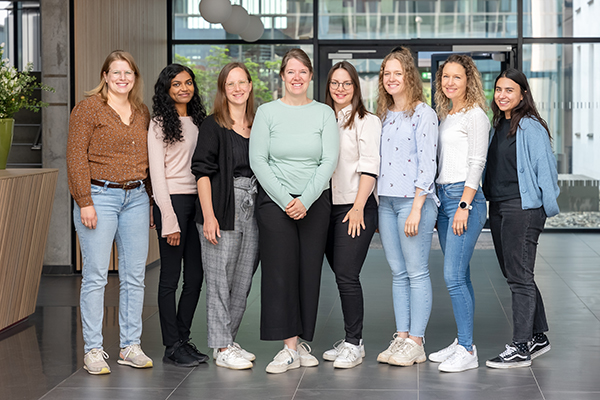The human brain consists of nearly 100 billion neurons and a similar number of non-neuronal cells. It is extremely complex and capable of the most complex performances. Changes in physiology along the neurons, e.g., due to ion channel defects or disturbances in neuronal migration, can lead to severe diseases, including epileptic encephalopathies. Epilepsies can also be the direct cause of a brain structural abnormality. Therefore, the diagnostic panel also includes all known genes associated with brain malformations, regardless of the description of a seizure disorder.
The Diagnostic Panel for Epilepsie and Brain Development Disorders comprises 577 genes and is based on our proprietary, high-quality ExomeXtra® enrichment, covering all protein-coding regions as well as intronic and intergenic variants described as disease-relevant in the databases HGMD and ClinVar. In addition, the ExomeXtra® enrichment enables a genome-wide CNV calling with similar performance to array CGH. It thus provides the ideal basis for genetic diagnostics.
Are you insured in Germany? Our colleagues at the Zentrum für Humangenetik Tübingen will gladly support you!
What We Offer with the Panel for Epilepsy & Brain Development Disorders
Our Promise to You
Your Benefits
It is possible to request single or multiple predefined gene sets. In addition to the complete analysis of the genes of the requested gene set, we extend the analysis by additional genes for differential diagnosis. We report variants of unknown significance (ACMG class 3) and pathogenic and probably pathogenic variants (ACMG classes 4 and 5) for the primarily ordered gene set. For the genes included due to differential diagnosis, we restrict the reporting to pathogenic and probably pathogenic variants (ACMG classes 4 and 5), which could be related to the indication of the person seeking advice.
The Diagnostic Panel for Epilepsy & Brain Development Disorders is based on CeGaT’s ExomeXtra® enrichment. This allows, without additional sequencing, phenotypically eligible gene sets of other CeGaT panels or single genes to be additionally ordered. If you would like to assemble an individual panel, please feel free to contact us. We will be happy to support you.
In addition to the primary diagnostic assignment, the assessment of ACMG genes and pharmacogenetic profiling may also be ordered.
Method
The enrichment of the coding regions and the adjacent intronic regions is performed using an in-solution hybridization technology. The selection of the targeted regions and the design of the enrichment baits is performed in-house. High-throughput sequencing is performed on our Illumina platforms. Bioinformatic processing of the data is achieved using an in-house computer cluster.
Following data processing, our team of scientists and specialists in human genetics analyze the data and issue a medical report.
Sample Report
General Information
Material
- 1-2 ml EDTA blood (recommended sample type) or
- 1-2 µg genomic DNA
- Order Form with declaration of consent
Here you can find more information on how to ship your sample safely.
Costs
The prices for our human genetic diagnostics depend on the size of the selected diagnostic panel and the selected gene sets. All prices include sequencing, bioinformatic analysis, and issuing of a medical report by our team of experts in human genetic diagnostics.
Gene Sets — Epilepsy
Epileptic Encephalopathy (EPI02, 151 Genes)
AARS1, ABAT, ACTL6B, ADAM22, ALDH7A1, ALG13, AMT, AP2M1, AP3B2, ARHGEF9, ARV1, ARX, ATP6V1A, BRAT1, CACNA1A, CACNA1B, CACNA1E, CAD, CAMK2A, CAMK2B, CDK19, CDKL5, CHD2, CLCN4, CNPY3, CPLX1, CUL3, CUX2, CYFIP2, DALRD3, DDX3X, DENND5A, DMXL2, DNM1, DOCK7, EEF1A2, EIF3F, FGF12, FGF13, FOXG1, FRRS1L, GABBR2, GABRA1, GABRA2, GABRA5, GABRB1, GABRB2, GABRB3, GABRG2, GAD1, GAMT, GLDC, GLS, GNAO1, GNB1, GOT2, GRIA4, GRIN1, GRIN2A, GRIN2B, GRIN2D, GRM7, GUF1, HCN1, HNRNPU, IQSEC2, ITPA, KCNA2, KCNB1, KCNQ2, KCNQ5, KCNT1, KCNT2, LNPK, MBD5, MBOAT7, MDH1, MDH2, MECP2, MEF2C, MOCS1, MOCS2, NARS1, NBEA, NCDN, NECAP1, NEUROD2, NEXMIF, NTRK2, NUS1, PACS2, PARS2, PCDH19, PHACTR1, PIGA, PIGB, PIGP, PIGQ, PIGS, PLCB1, PLPBP, PNKP, PNPO, POLG, PPP2CA, PPP2R1A, PPP2R5D, PPP3CA, PTPN23, PURA, RHOBTB2, RNF13, ROGDI, RORA, SCN1A, SCN1B, SCN2A, SCN3A, SCN8A, SIK1, SLC12A5, SLC13A5, SLC1A2, SLC25A12, SLC25A22, SLC2A1, SLC35A2, SLC6A1, SLC6A8, SLC9A6, SMC1A, SPTAN1, ST3GAL3, STXBP1, SYNGAP1, SYNJ1, SZT2, TANC2, TBC1D24, TBL1XR1, TCF4, TRAK1, TSC1, TSC2, UBA5, UBE3A, UGDH, UGP2, WWOX, YWHAG, ZEB2
Progressive Myoclonus Epilepsy (EPI05, 17 Genes)
AFG3L2, ASAH1, CERS1, CSTB, EPM2A, GOSR2, KCNC1, KCTD7, LMNB2, NEU1, NHLRC1, PRDM8, PRICKLE1, SCARB2, SEMA6B, SERPINI1, SLC7A6OS
**CSTB repeat analysis not required
(associated with Unverricht-Lundborg disease, a slowly progressive myoclonus epilepsy)
The most common pathogenic alteration in CSTB is a dodecamer repeat expansion in the promotor region, which cannot be detected by NGS.
Gene Sets — Brain Development Disorders
Primary Microcephaly and Differential Diagnoses (BRN01, 68 Genes)
ANKLE2, ASNS, ASPM, ATR, CDC45, CDC6, CDK5RAP2, CDK6, CDT1, CENPE, CENPF, CENPJ, CEP135, CEP152, CEP63, CIT, COPB2, CTNNA2, DNA2, DONSON, DYRK1A, GMNN, KIF11, KIF14, KIF2A, KIF5C, KNL1, LMNB1, LMNB2, MCM5, MCPH1, MFSD2A, NBN, NCAPD2, NCAPD3, NCAPH, NIN, NSMCE2, NUP37, ORC1, ORC4, ORC6, PCNT, PHC1, PHGDH, PLK4, PNKP, PSAT1, PSPH, RBBP8, RNU4ATAC, RRP7A, RTTN, SASS6, STIL, TRAIP, TRAPPC14, TUBA8, TUBB, TUBB2A, TUBB2B, TUBB3, TUBG1, TUBGCP4, TUBGCP6, WDFY3, WDR62, ZNF335
Neuronal Migration Disorders (BRN02, 76 Genes)
ACTB, ACTG1, ADGRG1, AKT3, APC2, ARF1, ARFGEF2, ARX, B3GALNT2, B4GAT1, CCND2, CDK5, CEP85L, COL3A1, COL4A1, COL4A2, CRADD, CRPPA, CTNNA2, DAG1, DCX, DYNC1H1, ERMARD, FAT4, FKRP, FKTN, FLNA, GMPPB, GRIN1, GRIN2B, KATNB1, KIF2A, KIF5C, KIFBP, LAMB1, LAMC3, LARGE1, MACF1, MAP1B, MAST1, NDE1, NEDD4L, OCLN, PAFAH1B1, PI4KA, PIK3CA, PIK3R2, POMGNT1, POMGNT2, POMK, POMT1, POMT2, PRUNE1, RAB18, RAB3GAP1, RAB3GAP2, RAC3, RELN, RTTN, RXYLT1, SNAP29, STAT2, TBC1D20, TMTC3, TSC1, TSC2, TUBA1A, TUBB, TUBB2A, TUBB2B, TUBB3, TUBG1, TUBGCP2, VLDLR, WDR62, WDR81
Macrocephaly (BRN04, 62 Genes)
AKT1, AKT2, AKT3, APC2, ASPA, ASXL2, BRWD3, CCND2, CDKN1C, CHD3, CHD4, CHD8, CRADD, DIS3L2, DNMT3A, EED, EZH2, GCDH, GFAP, GLI3, GPC3, H1-4, HEPACAM, HERC1, HRAS, HUWE1, KIF7, KPTN, L1CAM, MITF, MLC1, MPDZ, MTOR, NF1, NFIA, NFIB, NFIX, NONO, NSD1, PAK1, PHF6, PIGA, PIK3CA, PIK3R2, PPP1CB, PPP2R5B, PPP2R5C, PPP2R5D, PTCH1, PTEN, RAB39B, RIN2, RNF125, SETD2, SOS1, STRADA, SUFU, SUZ12, TBC1D7, TRIO, UPF3B, ZBTB20
Leukodystrophy / Leukoencephalopathy (BRN05, 86 Genes)
AARS1, AARS2, ABCD1, ACBD5, ACOX1, ADAR, AIMP1, AIMP2, ALDH3A2, ARSA, ASPA, BCAP31, CLCN2, CLDN11, CNP, CSF1R, CTC1, CYP27A1, DARS1, DARS2, DEGS1, EARS2, EIF2AK2, EIF2B1, EIF2B2, EIF2B3, EIF2B4, EIF2B5, EPRS1, FAM126A, GALC, GAN, GBE1, GFAP, GJC2, HEPACAM, HIKESHI, HSD17B4, HSPD1, HTRA1, IFIH1, KARS1, L2HGDH, LMNB1, LSM11, MLC1, NAXD, NAXE, NKX6-2, NOTCH3, OCLN, PLAA, PLEKHG2, PLP1, POLR1C, POLR3A, POLR3B, POLR3K, PSAP, PYCR2, RAB11B, RARS1, RNASEH2A, RNASEH2B, RNASEH2C, RNASET2, RNU7-1, SAMHD1, SCP2, SLC16A2, SLC17A5, SLC25A12, SNORD118, SOX10, STAT2, STN1, SUMF1, TMEM106B, TMEM63A, TREM2, TREX1, TUBB4A, TYROBP, UFM1, VPS11, ZNHIT3
Joubert Syndrome (BRN07, 43 Genes)
AHI1, ARL13B, ARL3, ARMC9, B9D1, B9D2, C2CD3, CC2D2A, CEP104, CEP120, CEP164, CEP290, CEP41, CPLANE1, CSPP1, FAM149B1, HYLS1, IFT172, INPP5E, KATNIP, KIAA0586, KIAA0753, KIF7, MKS1, NPHP1, OFD1, PDE6D, PIBF1, POC1B, RPGRIP1L, SUFU, TCTN1, TCTN2, TCTN3, TMEM107, TMEM138, TMEM216, TMEM231, TMEM237, TMEM67, TOGARAM1, TTC21B, ZNF423
Gene Directory — Panel for Epilepsy & Brain Development Disorders
AARS1, AARS2, ABAT, ABCD1, ACBD5, ACOX1, ACTB, ACTG1, ACTL6B, ADAM22, ADAR, ADGRG1, AFG3L2, AHI1, AIMP1, AIMP2, AKT1, AKT2, AKT3, ALDH3A2, ALDH7A1, ALG13, AMPD2, AMT, ANKLE2, ANKRD11, AP2M1, AP3B2, APC2, ARF1, ARFGEF2, ARHGEF9, ARID1A, ARID1B, ARID2, ARL13B, ARL3, ARMC9, ARSA, ARV1, ARX, ASAH1, ASNS, ASPA, ASPM, ASXL2, ATAD1, ATP13A2, ATP1A2, ATP1A3, ATP6V1A, ATR, B3GALNT2, B4GAT1, B9D1, B9D2, BCAP31, BICRA, BRAT1, BRD4, BRWD3, C2CD3, CACNA1A, CACNA1B, CACNA1E, CAD, CAMK2A, CAMK2B, CASK, CC2D2A, CCND2, CDC40, CDC45, CDC6, CDK19, CDK5, CDK5RAP2, CDK6, CDKL5, CDKN1C, CDON, CDT1, CENPE, CENPF, CENPJ, CEP104, CEP120, CEP135, CEP152, CEP164, CEP290, CEP41, CEP63, CEP85L, CERS1, CHD2, CHD3, CHD4, CHD7, CHD8, CHMP1A, CHRNA2, CHRNA4, CHRNB2, CIT, CLCN2, CLCN4, CLDN11, CLN3, CLN5, CLN6, CLN8, CLP1, CNOT1, CNP, CNPY3, COASY, COL3A1, COL4A1, COL4A2, COPB2, CPLANE1, CPLX1, CRADD, CRPPA, CSF1R, CSPP1, CSTB, CTC1, CTNNA2, CTSD, CTSF, CUL3, CUX2, CYFIP2, CYP27A1, DAG1, DALRD3, DARS1, DARS2, DCX, DDX3X, DEGS1, DENND5A, DEPDC5, DHCR7, DIS3L2, DISP1, DLL1, DMXL2, DNA2, DNAJC5, DNM1, DNMT3A, DOCK7, DONSON, DPF2, DYNC1H1, DYRK1A, EARS2, EED, EEF1A2, EIF2AK2, EIF2B1, EIF2B2, EIF2B3, EIF2B4, EIF2B5, EIF3F, EPM2A, EPRS1, ERMARD, EXOSC1, EXOSC3, EXOSC8, EXOSC9, EZH2, FAM126A, FAM149B1, FAT4, FGF12, FGF13, FGF8, FGFR1, FKRP, FKTN, FLNA, FOXG1, FRRS1L, GABBR2, GABRA1, GABRA2, GABRA5, GABRB1, GABRB2, GABRB3, GABRG2, GAD1, GALC, GAMT, GAN, GBE1, GCDH, GFAP, GJC2, GLDC, GLI2, GLI3, GLRA1, GLRB, GLS, GMNN, GMPPB, GNAO1, GNB1, GOSR2, GOT2, GPAA1, GPC3, GRIA4, GRIN1, GRIN2A, GRIN2B, GRIN2D, GRM7, GRN, GUF1, H1-4, HCN1, HDAC8, HEPACAM, HERC1, HIKESHI, HNRNPU, HRAS, HSD17B4, HSPD1, HTRA1, HUWE1, HYLS1, IFIH1, IFT172, INPP5E, IQSEC2, ITPA, KATNB1, KATNIP, KCNA1, KCNA2, KCNB1, KCNC1, KCNMA1, KCNQ2, KCNQ3, KCNQ5, KCNT1, KCNT2, KCTD7, KDM6A, KIAA0586, KIAA0753, KIF11, KIF14, KIF2A, KIF5C, KIF7, KIFBP, KMT2D, KNL1, KPTN, L1CAM, L2HGDH, LAMB1, LAMC3, LARGE1, LGI1, LMNB1, LMNB2, LNPK, LSM11, MACF1, MAP1B, MAST1, MBD5, MBOAT7, MCM5, MCPH1, MDH1, MDH2, MECP2, MEF2C, MFSD2A, MFSD8, MITF, MKS1, MLC1, MOCS1, MOCS2, MPDZ, MTOR, NARS1, NAXD, NAXE, NBEA, NBN, NCAPD2, NCAPD3, NCAPH, NCDN, NDE1, NECAP1, NEDD4L, NEU1, NEUROD2, NEXMIF, NF1, NFIA, NFIB, NFIX, NHLRC1, NIN, NIPBL, NKX6-2, NONO, NOTCH3, NPHP1, NPRL2, NPRL3, NSD1, NSMCE2, NTRK2, NUP37, NUS1, OCLN, OFD1, ORC1, ORC4, ORC6, PACS2, PAFAH1B1, PAK1, PARS2, PCDH19, PCLO, PCNT, PDE6D, PGAP1, PGAP2, PGAP3, PHACTR1, PHC1, PHF6, PHGDH, PI4KA, PIBF1, PIGA, PIGB, PIGC, PIGF, PIGG, PIGH, PIGK, PIGL, PIGM, PIGN, PIGO, PIGP, PIGQ, PIGS, PIGT, PIGU, PIGV, PIGW, PIGY, PIK3CA, PIK3R2, PLAA, PLCB1, PLEKHG2, PLK4, PLP1, PLPBP, PNKP, PNPO, POC1B, POLG, POLR1C, POLR3A, POLR3B, POLR3K, POMGNT1, POMGNT2, POMK, POMT1, POMT2, PPIL1, PPP1CB, PPP2CA, PPP2R1A, PPP2R5B, PPP2R5C, PPP2R5D, PPP3CA, PPT1, PRDM8, PRICKLE1, PRRT2, PRUNE1, PSAP, PSAT1, PSPH, PTCH1, PTEN, PTPN23, PURA, PYCR2, RAB11B, RAB18, RAB39B, RAB3GAP1, RAB3GAP2, RAC3, RAD21, RARS1, RARS2, RBBP8, RELN, RHOBTB2, RIN2, RNASEH2A, RNASEH2B, RNASEH2C, RNASET2, RNF125, RNF13, RNU4ATAC, RNU7-1, ROGDI, RORA, RORB, RPGRIP1L, RRP7A, RTTN, RXYLT1, SAMHD1, SASS6, SCARB2, SCN1A, SCN1B, SCN2A, SCN3A, SCN8A, SCP2, SEMA6B, SEPSECS, SERPINI1, SETD2, SHH, SIK1, SIX3, SLC12A5, SLC13A5, SLC16A2, SLC17A5, SLC1A2, SLC1A3, SLC25A12, SLC25A22, SLC25A46, SLC2A1, SLC35A2, SLC6A1, SLC6A5, SLC6A8, SLC7A6OS, SLC9A6, SMARCA2, SMARCA4, SMARCB1, SMARCC2, SMARCD1, SMARCE1, SMC1A, SMC3, SNAP29, SNORD118, SOS1, SOX10, SOX11, SOX4, SPTAN1, ST3GAL3, STAG2, STAT2, STIL, STN1, STRADA, STX1B, STXBP1, SUFU, SUMF1, SUZ12, SYNGAP1, SYNJ1, SZT2, TANC2, TBC1D20, TBC1D23, TBC1D24, TBC1D7, TBL1XR1, TCF4, TCTN1, TCTN2, TCTN3, TDGF1, TGIF1, TMEM106B, TMEM107, TMEM138, TMEM216, TMEM231, TMEM237, TMEM63A, TMEM67, TMTC3, TOE1, TOGARAM1, TPP1, TRAIP, TRAK1, TRAPPC14, TREM2, TREX1, TRIO, TSC1, TSC2, TSEN15, TSEN2, TSEN34, TSEN54, TTC21B, TUBA1A, TUBA8, TUBB, TUBB2A, TUBB2B, TUBB3, TUBB4A, TUBG1, TUBGCP2, TUBGCP4, TUBGCP6, TYROBP, UBA5, UBE2A, UBE3A, UFM1, UGDH, UGP2, UPF3B, VLDLR, VPS11, VPS51, VPS53, VRK1, WDFY3, WDR62, WDR81, WWOX, YWHAG, ZBTB20, ZEB2, ZIC2, ZNF335, ZNF423, ZNHIT3
Additional Services
HLA-Typing (HLA01)
HLA class I (Gene A, B, C) and HLA class II (Gene DPA1, DPB1, DQA1, DQB1, DRB1, DRB3, DRB4, DRB5)
ACMG Genes
Genetic variation may sometimes be identified, which does not fit within the scope of the requested genetic analysis (so-called secondary findings). The reporting of these variants is limited to pathogenic alterations (ACMG classes 4 and 5) within selected genes, for which a treatment or course of action exists for you or your family (according to the current guidelines of the American College of Medical Genetics and Genomics). Details on genes and associated diseases can be found here.
Pharmacogenetics
Pharmacogenetic analysis detects genetic changes that affect the effectiveness of drugs. Genetic variants that affect proteins responsible for the metabolism of substances can significantly change their tolerance and efficacy. These drugs include, among others, antidepressants, pain relievers, neuroleptics, chemotherapeutics, AIDS drugs, thrombosis drugs, anesthetics, beta-blockers, or statins.
The reduced activity of a specific enzyme can lead to an increased drug level in the standard dosage, which is often associated with undesirable side effects. With drugs that are only activated by metabolism, the therapeutic effect can be completely absent. Likewise, due to the resulting increased rate of degradation of the medicinal substance, an increased enzyme activity leads to inadequate effectiveness of the therapy.
The pharmacogenetics option analyzes known variants in twenty-two genes involved in the metabolism of drugs. If specific gene variants occur, the treating doctor can adapt the therapy individually. The pharmacogenetic analysis can minimize serious side effects and helps to avoid failure of the treatment.
Contact Us
Do you have a question, or are you interested in our service?
Diagnostic Support
We will assist you in selecting the diagnostic strategy – for each patient.




